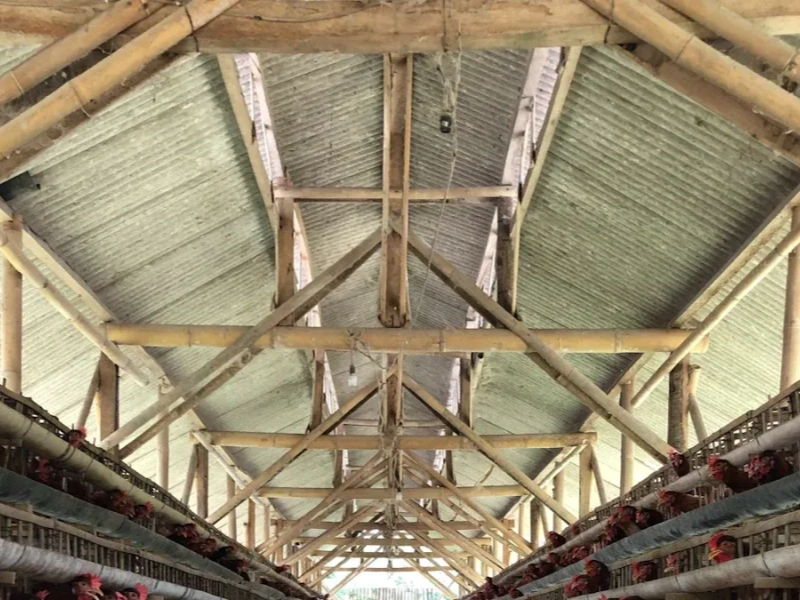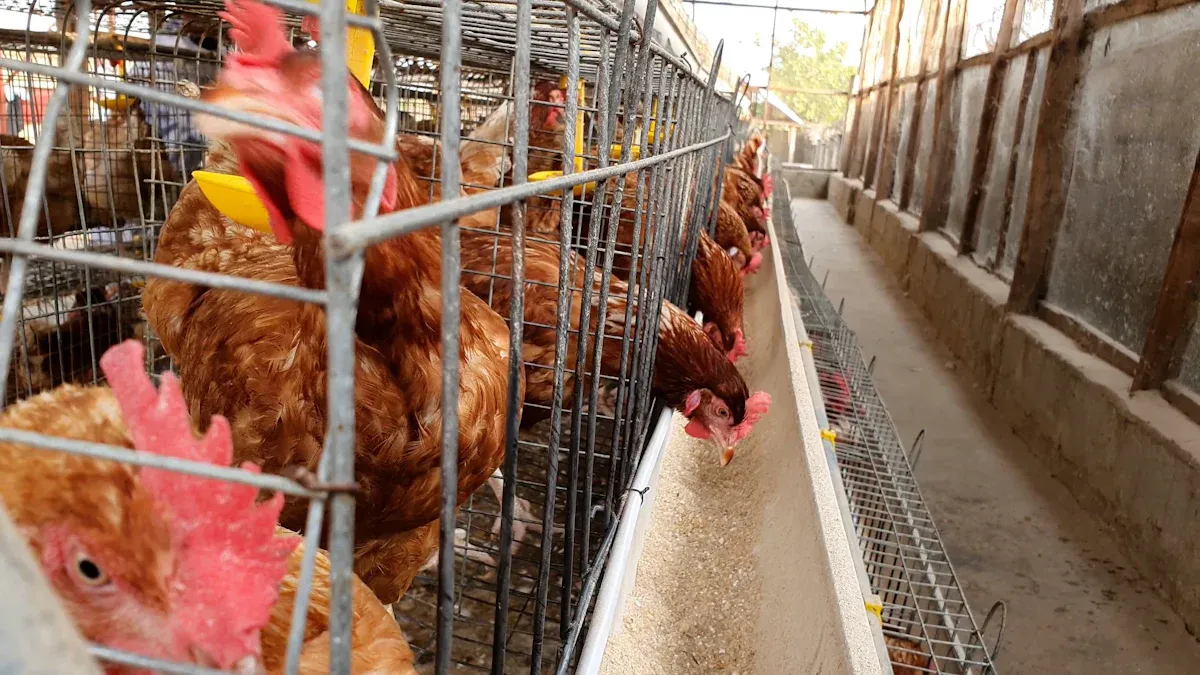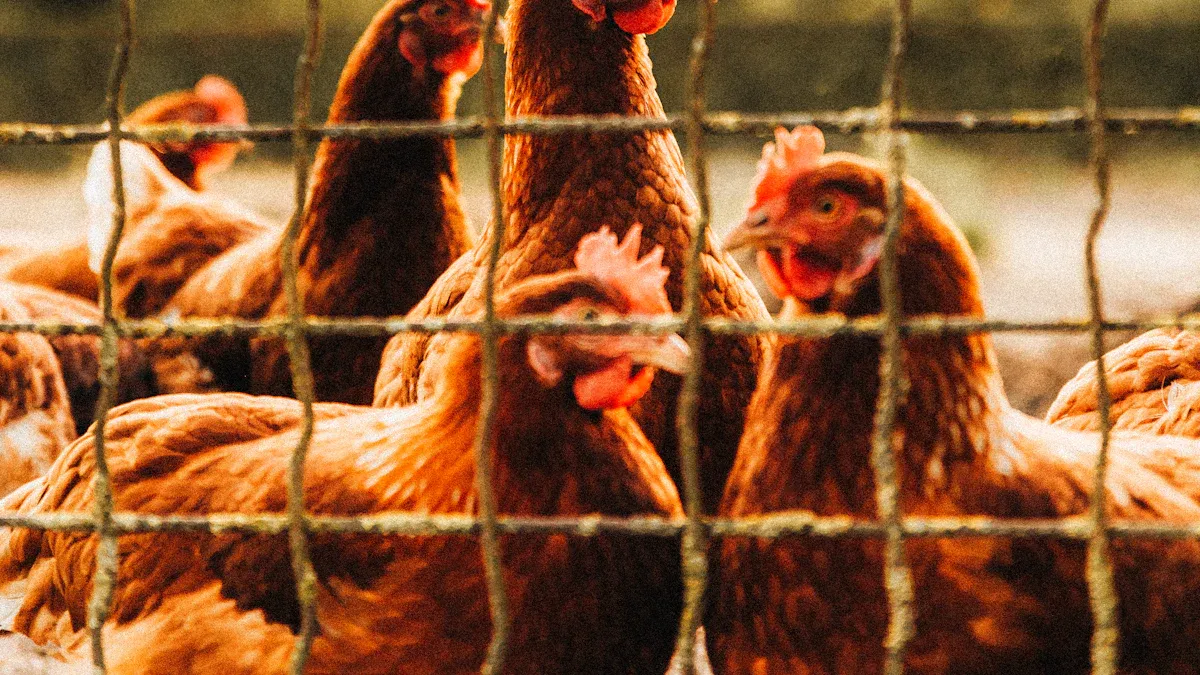
How to choose the best poultry cages
Choosing the right poultry cages keeps your birds healthy and safe. The cage type affects their health and your farm’s success. Breeder cages help keep poultry stock strong and healthy. Galvanized steel cages last long and save money. Research shows enriched cages lower death rates without raising feed costs. If you want cleanliness, flexibility, or value, pick the right cage. A good cage gives your birds a steady home and helps them produce well.
Key Takeaways
- Picking the right cage is important for bird health and farm success.
- Choose cages made from strong materials like galvanized steel to last longer and save money.
- Proper airflow in cages stops harmful gases, keeping birds healthy and productive.
- Pick cages that are simple to clean to keep them hygienic and stop diseases.
- Think about cage size to prevent overcrowding, which causes stress and sickness.
Types of Poultry Cages

A type laying hen cage
A type laying hen cages are great for small farms. These cages have two or three levels stacked up. Each level gives hens space to lay eggs comfortably. The slanted floor lets eggs roll safely into a tray. This design helps prevent eggs from breaking.
These cages are good for steady egg production. They save space, so they work well on small farms. Newer A type cages have automatic feeders and water systems. These features save time and make work easier.
H type laying hen cage
H type laying hen cages are best for big farms. They have many levels stacked vertically to use space well. Each level has nests, perches, and feeders for the hens. This setup helps hens stay healthy and lay more eggs.
Furnished H type cages give hens more room to move. Hens can perch and scratch, which keeps them happy. These cages also have automatic systems for egg collection and cleaning. This makes them very useful for large farms.
H type broiler cage
H type broiler cages are made for raising meat chickens. They give chickens enough room and air to grow fast. Smooth floors and good airflow keep chickens safe and healthy.
These cages are built with strong materials like steel to last long. Big sliding doors make it easy to feed or check the chickens. H type broiler cages are great for producing meat while keeping chickens healthy.
Brooding cage
Brooding cages are important for raising baby chicks safely. These cages create a safe place for chicks to grow well. They protect chicks from bad weather, predators, and sickness. A good brooding cage gives chicks warmth, fresh air, and enough space.
Pick a brooding cage with features that help chicks stay healthy. Heating is very important since chicks can’t control their body heat. Many cages have heating lamps or pads to keep them warm. Fresh air is also needed to stop harmful gases like ammonia from building up.
The cage size is also important. Crowded cages can stress chicks and make them sick. Choose a cage with enough room for chicks to move around. Some cages have parts you can adjust to make more space as chicks grow. This can save money over time.
Cleaning the cage should be easy too. Chicks make a lot of mess, so look for cages with trays or slatted floors. These features make cleaning faster and keep chicks healthy by reducing germs.
Most brooding cages come with feeders and waterers made for chicks. These tools help chicks eat and drink without spilling. A good brooding cage can help more chicks survive and grow into healthy birds.
Key Factors to Consider for Poultry Cages
Size
The size of poultry cages affects bird health and comfort. Bigger cages let birds move freely, lowering stress and injuries. For instance, enriched cages are larger than regular ones. They allow natural actions like nesting and perching. This helps birds stay healthy and prevents problems like bumblefoot.
| Aspect | Enriched Cages | Conventional Cages |
|---|---|---|
| Cage Size | Bigger, allows movement and behaviors | Smaller, limits movement |
| Natural Behaviors | Supported (e.g., nesting, perching) | Blocked (e.g., wing flapping) |
| Welfare Impact | Better (less stress, fewer injuries) | Worse (more stress, injuries) |
Think about the number of birds and their growth stages. Overcrowding causes stress and sickness. Spacious cages keep birds healthier and more productive.
Material
The material of cages affects how long they last and how easy they are to clean. Galvanized steel is strong and doesn’t rust, making it a top choice. Strong materials also protect against pecking and outside dangers.
Plastic-coated wires are smooth and prevent foot injuries. But they don’t last as long as steel. Pick materials that are both durable and comfortable for birds.
Ventilation
Good ventilation keeps fresh air flowing in poultry cages. This is important for bird health. Poor airflow can cause harmful gases like ammonia to build up. This leads to breathing problems. Open designs or mesh sides improve air circulation and keep birds healthy.
Research shows well-ventilated cages reduce stress and sickness. This improves bird productivity. For example, H type broiler cages have great airflow systems. These systems help meat chickens grow well.
Ease of Cleaning
Keeping cages clean is very important for bird health. Dirty cages can cause diseases. Choose cages that are easy to clean. Removable trays are helpful. These trays catch droppings and slide out easily. Cleaning them stops harmful bacteria from growing.
Wire or slatted floors are also useful. Waste falls through these floors, keeping the cage dry. This design keeps birds away from waste, lowering infection risks.
Some cages have automatic cleaning systems. These systems use belts to remove waste quickly. They save time and effort, especially on big farms. Though they cost more, they are worth it for large setups.
Durability
Strong cages last longer and save money over time. Galvanized steel is a great choice. It doesn’t rust and handles bad weather well. This makes it perfect for outdoor use.
Plastic-coated wires are smooth and protect birds’ feet. But they don’t last as long as steel. For long-term use, pick materials that can handle wear and tear.
Check how the cage is built. Strong frames and welded joints make cages sturdy. They can hold birds and equipment without breaking. A well-made cage needs fewer repairs and lasts longer.
Cost
Cost is an important factor when buying cages. Cheap cages may seem good but might not last. High-quality cages cost more but save money in the long run.
Compare prices from different sellers. Look for cages with good airflow, easy cleaning, and strong materials. Don’t pick low-quality cages to save money. Poor quality leads to higher repair costs later.
How Poultry Cages Impact Health and Productivity

Preventing Stress and Disease
Well-made poultry cages help lower stress and stop diseases. Stress weakens birds, making them get sick more easily. Cages that let birds perch or nest keep them calm. For example, research shows perching makes hens’ bones stronger. Stronger bones mean fewer breaks or injuries. Studies also found hens in enriched cages have healthier bones than those in small cages.
Good cage designs also stop diseases from spreading. Ventilated cages bring fresh air and remove harmful gases. Easy-to-clean cages stop bacteria from growing. Picking the right cage keeps your birds safe and healthy.
Enhancing Egg and Meat Production
The way cages are built affects egg and meat production. Enriched cages let hens nest, which helps them lay eggs better. Hens in these cages don’t hold eggs for long, so they lay more. The table below compares battery cages to enriched cages:
| Aspect | Battery Cages | Enriched Cages |
|---|---|---|
| Physical Welfare | More injuries like bumblefoot | Fewer injuries, better health |
| Behavioral Welfare | Birds can’t move or act naturally | Birds can perch and nest freely |
| Productivity | Eggs held longer, less efficient | Eggs laid faster, more productive |
For meat, cages like H type broiler cages are great. They give birds space and good airflow to grow well. Smooth floors and fresh air lower stress and injuries. This leads to better meat quality. Using good cages improves egg and meat production while keeping birds healthy.
Budget and Long-Term Value of Poultry Cages
Balancing Cost and Quality
Picking poultry cages needs a balance between cost and quality. Strong cages may cost more at first but save money later. Materials like galvanized steel last long and resist rust. This means fewer replacements and better value over time.
Cheaper cages might seem like a good deal but can cost more. Weak cages may need repairs or replacements often. Poor designs can harm birds, raising health costs. For example, bad airflow or weak frames can cause bird deaths. Furnished cages are better for bird health and egg production. Studies show they lower bird deaths and keep egg output steady.
To choose wisely, check features like airflow, cleaning ease, and material strength. Spending more now can improve bird health and farm success later.
Long-Term Maintenance and Durability
The value of cages depends on how strong and easy to maintain they are. Galvanized steel or plastic-coated wires last longer and need less care. These materials resist rust and damage, making them great for long-term use.
Maintenance costs matter too. Research shows feed use stays the same in different cages. Colony cages, for example, last longer than battery cages and work just as well. Features like trays or automatic cleaners save time and effort.
Strong cages also keep birds safer. Good frames and welded parts stop breaks and protect birds. Over time, strong cages lower repair costs and keep your farm running smoothly.
Choosing durable, low-maintenance cages saves money and keeps birds healthy. This helps your farm succeed in the long run.
Picking the best poultry cages keeps birds healthy and productive. Things like size, material, airflow, and strength affect their well-being. A good cage lowers stress, stops sickness, and improves egg or meat output.
Here’s a simple checklist to help you:
- Pick a cage type that suits your birds.
- Make sure it has good airflow and is easy to clean.
- Use strong materials like galvanized steel.
- Weigh the cost against how long it will last.
Check out trusted brands like Livi Machinery for reliable choices.
FAQ
What is the best material for poultry cages?
Galvanized steel is the top choice for poultry cages. It doesn’t rust, lasts long, and works well outdoors. Plastic-coated wires are soft and protect birds’ feet but wear out faster. Pick materials that are strong and comfortable for birds.
How often should you clean poultry cages?
Clean your poultry cages at least once every week. Use trays or slatted floors to make cleaning simple. Regular cleaning stops bacteria, lowers disease risks, and keeps birds healthy.
Can poultry cages improve egg production?
Yes, good cages like enriched or H type cages help hens lay more eggs. These cages give space for nesting and perching, which reduces stress. Less stress means healthier hens and more eggs.
Are automatic systems worth the cost?
Automatic systems save time and effort, especially on big farms. Features like feeders, waterers, and cleaning belts make work easier. They cost more upfront but are worth it over time.
How do you choose the right cage size?
Choose a cage size based on how many birds you have. Overcrowded cages cause stress and sickness. Bigger cages let birds move freely and stay healthier.
